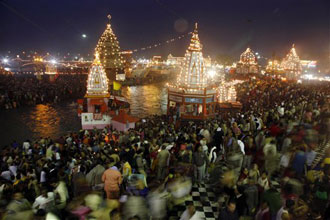Hindus Dip in Chilly Ganges During Kumbh Mela
Thousands of Hindu holy men, some naked and smeared with ash, took dips in the chilly waters of the Ganges river while surrounded by cheering, dancing supporters Friday, one of the most auspicious days of a monthslong festival expected to attract more than 10 million people.
Throughout the day, nearly 2 million devout Hindus — including large groups of sadhus, or holy men — are expected to bathe in the waters, which they consider sacred, said Anand Vardhan, the government official supervising the Kumbh Mela, often described as the world’s largest religious gathering.
Thousands of police equipped with closed-circuit television and metal detectors were on alert for terrorist attacks, stampedes and crime among the pilgrims, who will crowd into tents or sleep outside during the more than 100-day festival. Authorities made near-constant announcements on loudspeakers asking people to move in orderly lines to the specially marked bathing areas along the river banks.
“We are keeping an eye on every movement. We are well prepared for this day,” said Alok Sharma, the deputy inspector general of police.
The Hindu festival, which is celebrated every three years, rotates among four Indian cities.
On Jan. 13, it began in Haridwar, a temple-filled town at the foothills of the Himalayas where the Ganges river enters the sprawling plains of northern India. The festival ends April 28.
Thousands of pilgrims began taking dips before dawn on Friday with temperatures falling below 50 degrees (10 degrees Celsius). Devout Hindus believe bathing in the Ganges will cleanse them of their sins and free them from the cycle of life and rebirth.
“Because of the way the stars are aligned during the Kumbh, all the good things you do get multiplied and your sins are washed away,” said Anil Sharma, a lawyer who had traveled to Haridwar from Jaipur in western India’s Rajasthan state.
The main bathing areas were vacated for holy men, who started taking dips at about 11 a.m. (0530 GMT; 12:30 a.m. EST), marking the first “Shahi Snan” or Royal Bath.
The Shahi Snans are some of the most important events of Kumbh Mela. Thousands of holy men arrive at their specially designated bathing spots in large processions. Several carry swords and tridents and come riding on horses or being pulled in chariots.
Friday is also Shivaratri, a day devoted to the worship of the Hindu god Shiva.
The Kumbh Mela, or Pitcher Festival, derives its name from a mythical fight over a pitcher of holy nectar.
According to Hindu mythology, gods and demons waged a war over the nectar they needed to achieve immortality and victory. Four drops spilled, landing in the four cities that host the festival: Allahabad, the confluence of the Ganges, Yamuna and the mythic Saraswati rivers; Nasik, in the western state of Maharashtra; Ujjain, in central India, and in Haridwar.
___
Associated Press reporter Biswajeet Banerjee contributed to this report from Lucknow, India.
2/12/2010 5:52 AM MANISH SWARUP, Associated Press Writer HARIDWAR, India

Thousands of Devotees to take ritual holy dip on the first Shahi Sisnan or Royal bath, in the river Ganges, during the Kumbh Mela in Haridwar, India, Friday, Feb. 12, 2010. (AP Photo/Rajesh Kumar Singh)

